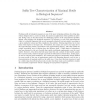Free Online Productivity Tools
i2Speak
i2Symbol
i2OCR
iTex2Img
iWeb2Print
iWeb2Shot
i2Type
iPdf2Split
iPdf2Merge
i2Bopomofo
i2Arabic
i2Style
i2Image
i2PDF
iLatex2Rtf
Sci2ools
BIRD
2008
Springer
2008
Springer
Suffix Tree Characterization of Maximal Motifs in Biological Sequences
Finding motifs in biological sequences is one of the most intriguing problems for string algorithms designers due to, on the one hand, the numerous applications of this problem in molecular biology and, on the other hand, the challenging aspects of the computational problem. Indeed, when dealing with biological sequences it is necessary to work with approximations (that is, to identify fragments that are not necessarily identical, but just similar, according to a given similarity notion) and this complicates the problem. Existing algorithms run in time linear with respect to the input size. Nevertheless, the output size can be very large due to the approximation (namely exponential in the approximation degree). This often makes the output unreadable, next to slowing down the inference itself. A high degree of redundancy has been detected in the set of motifs that satisfy traditional requirements, even for exact motifs. Moreover, it has been observed many times that only a subset of th...
| Added | 12 Oct 2010 |
| Updated | 12 Oct 2010 |
| Type | Conference |
| Year | 2008 |
| Where | BIRD |
| Authors | Maria Federico, Nadia Pisanti |
Comments (0)

